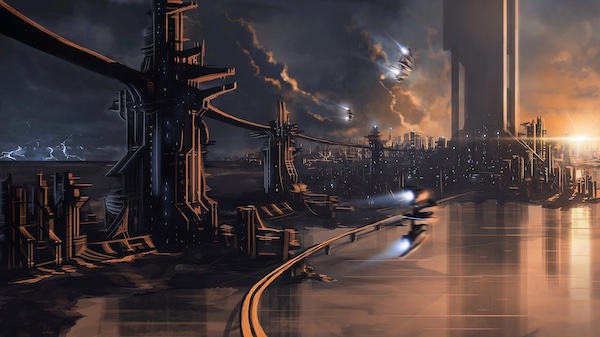
2024-09-27 12:05:02
By Michael Marano
In Megalopolis, we have Francis Ford Coppola, Titan of Cinema, unleashing his undiluted meditation on Roman History, US History, Political Rivalry and Cooperation, Urban Planning, Technology, Love, Marriage, etc.
Megalopolis, written and directed by Francis Ford Coppola. Screening at Alamo Drafthouse Boston and other movie houses in New England.

Adam Driver plays Cesar Catilina in Megalopolis.
This is going to be a very hard review to write, because I haven’t seen Francis Ford Coppola’s Megalopolis yet.
Oh, sure… I’ve sat through it.
But I haven’t seen it.
Because I’ve only viewed it once.
I have the same feeling about Megalopolis that I’ve had about every Kubrick movie since Barry Lyndon. Y’see… from Barry Lyndon on, Kubrick’s control of his films became absolute, due to his brother-in-law Jan Harlan taking over producer duties on his movies. And I disliked and was bored by the self-indulgence of all of Kubrick’s movies from Barry Lyndon on… until I saw them again. Those first viewings were Kubrick the Titan out to innovate cinema, and my dislike and lack of engagement was my moviegoer brain trying to catch up with the neural rewiring Kubrick achieved with those movies from Barry Lyndon on. I’ve had the same experience with a few Michael Haneke movies, like Cache and The White Ribbon.
So, with Megalopolis, we have Francis Ford Coppola, Titan of Cinema, unleashing his undiluted meditation on Roman History, US History, Political Rivalry and Cooperation, Urban Planning, Technology, Love, Marriage, etc. It’s a movie 40 years in the making, financed with 120 million bucks out of Coppola’s own pocket, and it has rewired my moviegoer brain in ways my frontal lobes have yet to process. I could process it and think it’s crap. But I know for a fact that walking out of Megalopolis, I had the same head buzz I had walking out of a 70mm showing of Apocalypse Now on opening night.
I have to see it again to really see it, with my newly rewired brain.
Megalopolis is an American fable, set in a retro-future Manhattan standing in for Rome at the Fall of the Republic which is in turn standing in for the US at this political and cultural moment. Adam Driver plays Cesar Catilina, an architect and city planner who is a blend, of course, of Julius Caesar and Roman conspirator Catiline and maybe Robert Moses? Add a dash of Preston Tucker (subject of Coppola’s biopic, Tucker: the Man and His Dream) and you have the kind of innovator/superman who will have Ayn Rand fans making nocturnal Fountainheads in their John Galt Underoos. Catilina is the inventor of the “megalon,” a building material that earned him the Nobel Prize (and which has a mysterious connection to Catilina’s dead wife). What does the megalon do? Basically whatever the plot necessitates, but the most pertinent thing seems to be its application toward creating cities that will (organically?) grow as the populations within them grow.
Oh, yeah… Catilina also has a superpower worthy of one of The Flash’s villains: he can stop time at will.
Catilina wants to knock down a bunch of multi-ethnic and affordable neighborhoods to build his Megalopolis development using the megalon. In opposition to him stands Giancarlo Esposito as Mayor Cicero, who’s much more conservative in his approach to… y’know… letting people have places to live.
Of course, Cicero has a beautiful daughter named Julia (Nathalie Emmanuel) whose loyalties will be tested between Catilina and her dad. Cue the soap opera organ.
Megalopolis is a movie of incredible opulence… there are textures and colors and compositions that are as rich as Renaissance paintings. The problem seems to be, especially in the early Fellini-like, super-decadent parts of the film, that Coppola doesn’t trust his own artistry regarding the power of this opulence. The world-building is disrupted by a number of quick cuts to build a kinetic sense of excess: the audience is not given an opportunity to acclimatize, a chance to orient themselves. There’s also an overreliance on voice overs and newscasts to stuff exposition into the audience’s skulls, and that comes off as especially ham-fisted, given the elegance of the film’s overall look and execution. At least one major character, a narrator of the film, in fact, just kind of disappears for too long a spell. All these are hints that make me think that, much like Apocalypse Now, we’re going to have multiple cuts of Megalopolis in the future.

A view of the city in Megalopolis.
There’s a lot of Fritz Lang’s Metropolis in Megalopolis. We have a conflict of the orders between the Have’s and Have Nots centered around urban infrastructure and resources. Also, in terms of conservative forces standing in opposition to advancing technology, there’s a lot of H. G. Welles’ Things to Come here, too. But, compared to Megalopolis, those two heady, ponderous science fiction metaphors are stripped down and breezy affairs. Megalopolis is an embarrassment of riches, in terms of plot, mise en scene, its plethora of characters. Coppola trips over his own feet. It’s stunningly beautiful to watch him do it, just like there’s beauty watching Nijinsky faceplant. As with Apocalypse Now, Coppola is making a movie about a guy playing God while he, himself, plays God. The totality of his control is admirable… but maybe he’s not in total control of himself?
Still, when Coppola swings for the fences, he hits it out of the megal-park. There’s an Urban Purgatory of Injustice sequence which is one of the most stunning things I’ve seen in years. A metaphoric, science fictional take on 9/11 and Ground Zero exudes a surreal beauty… followed a bit later by TV news clips of the real Ground Zero, which takes away from the power of the Ground Zero metaphor.
Megalopolis is undeniably a gargantuan mess. Despite the 40 years it took to make, it feels unfinished, and maybe it is. Or… like I said earlier, maybe what’s unfinished is my viewing of it. Coppola has brought the full force of his cinematic genius to bear here. It could well be that I have yet to catch up with his vision. But, for a movie about epic vision, the epic vision of the director himself might need to be ratcheted down — to allow for the epic vision of the characters to be seen and experienced and understood. Because, just as Mayor Cicero stands in the way of Catilina’s vision, so Coppola stands in Catilina’s way. Yeah, it’s a story about urban planning, but ultimately, it’s hard to see the forest through the trees of Megalopolis.
Novelist, writing coach, and personal trainer Michael Marano (www.BluePencilMike.com) is often asked what his favorite movie is. His typical answer is The Godfather and The Godfather Part II.





